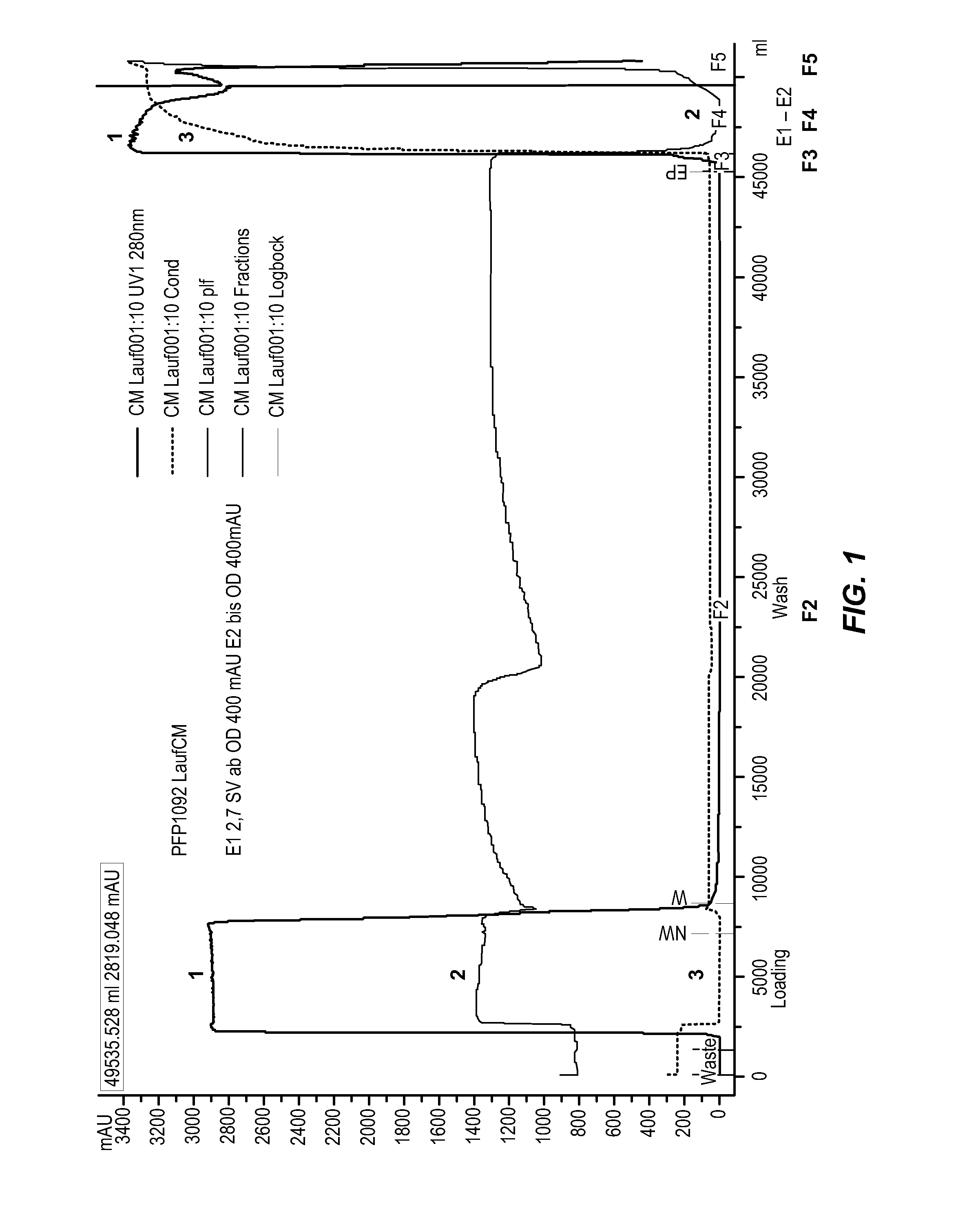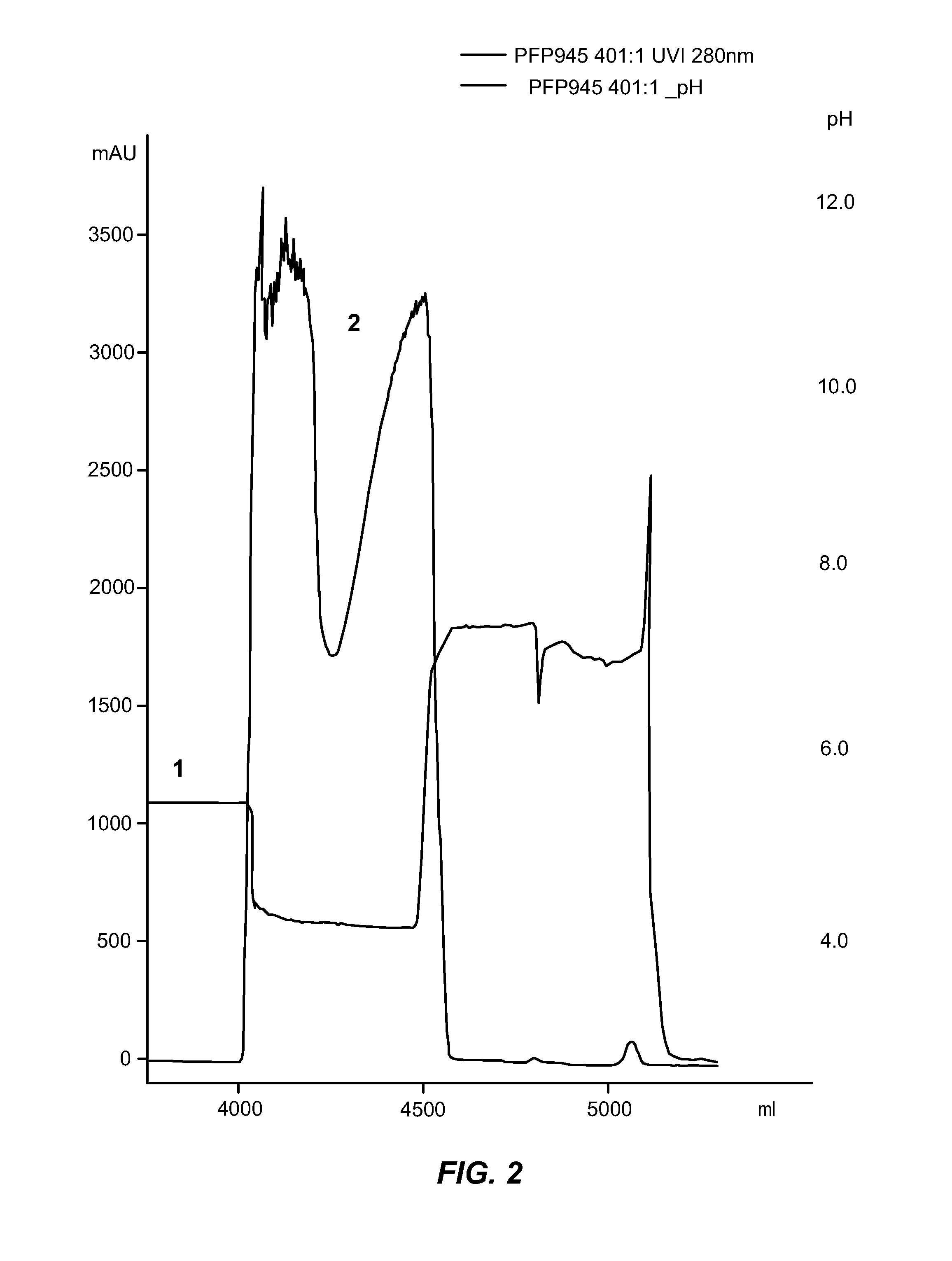Method for reducing the thromboembolic potential of a plasma-derived immunoglobulin composition
- Summary
- Abstract
- Description
- Claims
- Application Information
AI Technical Summary
Benefits of technology
Problems solved by technology
Method used
Image
Examples
example 1
[0246]This example describes the distribution of unwanted proteins causing elevated TGA, FXIa, and shortened NAPTT values from a Fraction II immunoglobulin composition prepared according to a modified Kistler-Nitschmann alcohol fractionation. These impurities can be separated during elution of a cation exchange chromatography step (e.g., CM Sepharose fast flow chromatography).
[0247]This example demonstrates a significant reduction in the amidolytic content (e.g., FXI and / or FXIa) during elution of cation exchange chromatography. The method results in a final immunoglobulin product containing significantly less TGA and FXIa activity. This reduction is achieved by a specific fractionation of the CM eluate step, which effectively separates amidolytic activity (present in the lagging portion of the eluate) from the main IgG fraction (found in the leading portion of the eluate). This example shows that by dividing the cation exchange eluate into leading and lagging portions, undesirable ...
example 2
[0257]In order to reduce the amount of amidolytic activity present in manufacturing-scale immunoglobulin preparations, the conditions used to elute and fractionate cation exchange chromatography were investigated. The details of these investigations are provided below.
[0258]A series of experiments was performed to find suitable solutions for reducing / removing amidolytic activity during downstream process according to the Gammagard SID production method described herein. Briefly, Cohn Fraction paste was dissolved in cold water at 4° C. and pH 5.2±0.2. After clarification by CWSS filtration the samples were either sterile filtrated and stored at 4° C. or diluted with water to a protein concentration of 2% for immediate processing. The solution was then brought to 20-25° C. and incubated for 1 hour with a solvent / detergent mixture (1% Triton X-100, 0.3% Tween 80; 0.3% TNBP) before the protein solution was loaded onto an equilibrated CM-Sepharose fast flow column (equilibration buffer: ...
example 3
[0260]To further investigate the bimodal CM-Sepharose elution phenomenon and pH shift observed in Example 1 and Example 2, individual elution fractions were collected during another CM-Sepharose fast flow chromatography experiment. Briefly, CM-Sepharose fast flow chromatography was performed as described above, with fractions collected and analyzed separately before pooling fractions A-N and concentrating by ultrafiltration The starting material for the chromatographic step was Cohn Fraction II paste (P25001ivLE; FIX and AT-III adsorbed). The CM-Sepharose column was equilibrated with buffer having a pH of 5.2 and washing was performed at a pH of 5.7. The flow rate of the chromatographic step was maintained at 0.64 cm / min.
[0261]After the pH shift, an increasing amount of amidolytic activity (PL-1) is found in the fractions. Even in the concentrated pool a reduction of the amidolytic activity is observed. The fact, that PL1 activity is detectable after ultra- / diafiltration is either d...
PUM
| Property | Measurement | Unit |
|---|---|---|
| Fraction | aaaaa | aaaaa |
| Fraction | aaaaa | aaaaa |
| Fraction | aaaaa | aaaaa |
Abstract
Description
Claims
Application Information
 Login to View More
Login to View More - Generate Ideas
- Intellectual Property
- Life Sciences
- Materials
- Tech Scout
- Unparalleled Data Quality
- Higher Quality Content
- 60% Fewer Hallucinations
Browse by: Latest US Patents, China's latest patents, Technical Efficacy Thesaurus, Application Domain, Technology Topic, Popular Technical Reports.
© 2025 PatSnap. All rights reserved.Legal|Privacy policy|Modern Slavery Act Transparency Statement|Sitemap|About US| Contact US: help@patsnap.com



